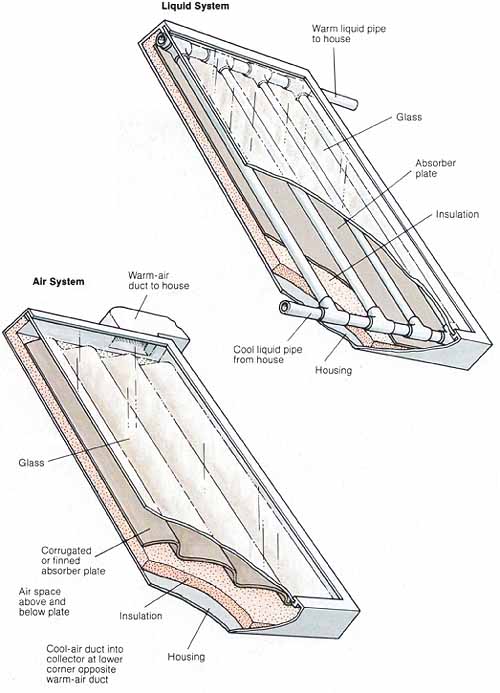As we saw earlier, active solar systems differ from passive solar systems
in that mechanical devices such as pumps and fans are used to transport heat
from collection to storage, or from storage to use.
Because active heating systems use mechanical components, they are generally
somewhat more complicated than passive systems in their operation; and they
are therefore more expensive to purchase, install, and maintain. On the
other hand, they are generally adaptable and automatic, capable of achieving
higher temperatures in shorter times over more extended periods than are
passive systems. and because they can be controlled by a thermostat, which
is not possible with a passive system, they do not require the close regulation
of heat intake necessary with a passive system. Finally, active equipment
is, on the whole, more compact and more readily adaptable to a variety of
heating tasks than the cumbersome pieces of the passive package.
For all their evident differences, how ever, passive and active solar heating
systems work on the same basic principles; and the success of any specific
system reflects its ability to collect, store, and distribute the heat from
solar energy in an efficient manner.
Air and Liquid Systems
Flat-plate collectors use either air or liquid (water, water-antifreeze
solutions, or — rarely — oil solutions) to transport heat from the
collection point to the storage unit, and then from storage unit
to the de sired points of distribution in the house.
If a liquid system (also called a water system or hydronic system)
is used, the solar-heated water itself is transported to a hot-water
storage tank, and carried from the tank through a pipe system to
the space to be heated. A pump pipes the hot water from collector
to storage and /or from storage to distribution.
If an air system is used, the solar- heated air is transported
to a bin of rocks, which absorb and retain the heat. Air blown across
the rocks picks up the heat and carries it through a system of ducts
to the desired distribution point. A fan or blower is used to duct
the solar-heated air from the collector to storage and /or from storage
to the distribution point.

Liquid System: Warm liquid pipe to house; Glass; Absorber
plate; Insulation; Cool liquid pipe from house; Housing
Air System: Warm-air duct to house; Corrugated or
finned absorber plate; Air space above and below plate; Cool-air
duct into collector at lower corner opposite warm-air duct; Housing;
Insulation. |
Next: Solar
Collectors and Placing the Collector
Prev: Ways
to Heat Your Space with the Sun
Top of page Similar Articles Home
|
